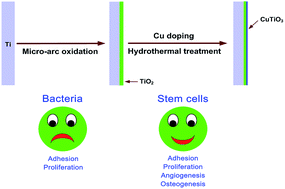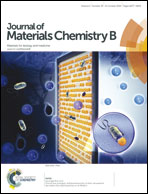Antibacterial property, angiogenic and osteogenic activity of Cu-incorporated TiO2 coating†
Abstract
Numerous efforts have been made to modify the surface topography and chemical composition of biomedical implants in order to enhance the antibacterial ability and the osteointegration between implants and surrounding bone tissue. In the present work, copper-incorporated TiO2 coatings were fabricated by combining micro-arc oxidation and hydrothermal treatment together to functionalize the surface of Ti implants. The as-prepared surfaces exhibited a hierarchical structure comprising nanoneedles nearly perpendicular to the microrough surface of the TiO2 coating. The Cu-loaded TiO2 coating possessed strong antimicrobial ability against Gram-negative Escherichia coli. In vitro cytocompatibility evaluation suggests that no significant cytotoxicity appeared on the Cu-incorporated TiO2 coating. Furthermore, the addition of the copper element could stimulate the expression of angiogenic genes, including the hypoxia-inducible factor-1α (HIF-1α) and vascular endothelial growth factor (VEGF) in rat bone marrow stem cells (BMSCs). Moreover, they tended to undergo osteogenic differentiation, indicated by the up-regulation expression of osteogenic markers and the higher level of alkaline phosphatase activity. This study provides insight for the surface modification of biomedical Ti-based implants. To the best of our best knowledge, this is a successful attempt for the first time to combine micro-arc oxidation and hydrothermal treatment to introduce copper nutrient element to functionalize Ti-based implant surfaces with enhanced angiogenesis potential, osteostimulation and antimicrobial properties that can better meet clinical needs.


 Please wait while we load your content...
Please wait while we load your content...